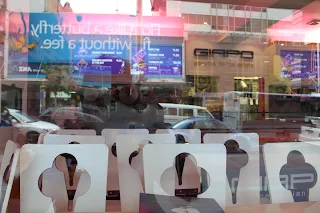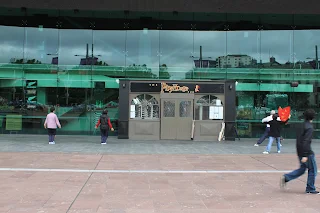There are many cuisine distractions at Level 5 of Sydney CBD's Pitt Street Mall Westfield. Becasse pastries, Charlie and Co burgers, Din Tai Fung dumplings, amongst others, vie for your wallet and attention. After a long day of business in the city centre, I wanted something quick, easy and relatively light in a meal before making track back to Wollongong (90 km south). I chose the wok prepared sar hor fun from Sassy's Red (image above). The noodles were as expected, but I found the gravy under whelming and lacked the street food flair found in Malaysia. The curry laksa, chiken or seafood, is much better in comparison.
Sassy's Red recreates the theme and spirit of the ubiquitous coffee shop (kopi tiam) still found in numerous towns and cities across Malaysia, Vietnam, Thailand and Indonesia. This is epitomised by the chopstick holder, marble table top and the classic coffee shop chair (picture above). The Laughing Buddha (foreground in image below) shows the connection of the operators of Sassy's Red with Cinta Ria, which offers another Malaysian dining experience at Sydney's Darling Harbour and that in Melbourne. The dishes with their names at the top of the photograph below are Malaysian favourites, especially chili prawns and chicken curry (best served with steamed jasmine or basmati rice). Nasi goreng and rendang beef is commonly available in Indonesia, Singapore and Malaysia. Notice the curry laksa and nasi lemak being available as well, and they are best taken at breakfast time. 



A variety of commonly used sauces in Chinese-Malaysian cooking are carefully displayed at one corner of the small Sassy's outlet at level 5 of Westfield Pitt Street Mall (picture above). Note the classic red coloured thermos flasks (commonly used by households for over a hundred years in the Malaya and Singapore of old) on the upper right corner, on the very top shelves.
The owners have also taken up one of the tenancies just a floor up on level 6 ( Cinta Ria, in the mood for love), together with Max Brenner chocolate, Chat Thai, Lombardian food at Spiedo and the Xanthi cuisine based on Constantinoiple and Perama cooking traditions.



































